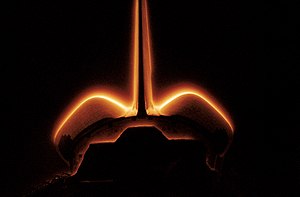STS-62
On Flight Day Two (Saturday, March 5), the astronauts took turns on the crew cabin exercise facility in an effort to slow down the effects of muscle atrophy.Pilot Andrew M. Allen and mission specialist Charles D. Gemar also spent time in the Lower Body Negative Pressure Container.Mission controllers in Houston also investigated a problem in a fuel line pressure sensor on one of Columbia's three Auxiliary Power Units (APUs).The bike aboard Columbia, however, featured a new mounting system of shock-absorbing springs that was evaluated as a method of keeping vibrations from exercise, which could disturb sensitive experiments, to a minimum.Although not highly visible except to the Earth-bound scientists watching over them, Columbia's wide assortment of external payloads continued their investigations throughout the day.Team members closely watched computer data traces which indicate their experiment was very near the critical temperature—the goal of a lengthy, methodical "sensitive" search process.The SAMS team began sending results of their data collection during various orbiter activities to the crew, as they were interested in how they could minimize their influence on the microgravity environment.Measurements were made with the system at specific times when microgravity disturbances were caused by events such as crew exercise and movement of the orbiter's Ku-band antenna.Downlinked experiment data from the third day of the mission indicated that solidification of a crystal of mercury cadmium telluride took place, and the AADSF science team constantly monitored this slow but steady progress.A reading of high pressure that was seen in a fuel line to one of the shuttle's three auxiliary power units earlier in the flight had dissipated, and controllers became confident the APU would operate well if needed.Gemar also continued his work with the Middeck 0-Gravity Dynamics Experiment, designed to study the fundamental, non-linear, gravity-dependent behavior of hybrid scaled structures.The other astronauts spent the first half of the day working with the Middeck 0-Gravity Dynamics Experiment, or MODE, and a model of a truss structure which was under consideration for use on a future space station.Once the team was certain they had located the critical point, they planned to conduct a series of precise measurements in the area surrounding it using laser light scattering.The Advanced Automated Directional Solidification Furnace (AADSF) continued to operate smoothly, growing a single cylinder-shaped crystal of mercury cadmium telluride, an exotic material used as an infrared radiation detector.The AADSF provided scientists with a unique apparatus in which to test theories of semiconductor crystal growth without the effects and limitations caused by Earth's gravity.Results included the operation of an advanced solar energy cell and plasma interactions with various materials while the orbiter's payload bay was pointed toward Earth.In the materials science field, the Advanced Automated Directional Solidification Furnace (AADSF) continued to grow a single crystal of mercury cadmium telluride in the microgravity environment of the orbiter's payload bay.The IDGE experimenters continued to monitor slow-scan video images of dendrites growing in their apparatus in order to maximize the efficiency of the instrument and the science results.On Flight Day 8 (Friday, March 11), marking the midpoint of the mission, Casper switched several of the environmental control systems to their backups for on-orbit check out.With the maneuver, Casper closed and opened sample trays for the Long Duration Space Environment Candidate Material Exposure (LDCE) experiment.During the latter part of the day on Saturday, the crew unlatched the Remote Manipulator System and used it to help troubleshoot some off-nominal reception from the Experimental Investigation of Spacecraft Glow instrument in the payload bay.During an in-flight news conference, the crew responded to questions ranging from budget cutbacks and safety, to experimentation and life on the then-future International Space Station.Shortly thereafter, observations by OAST-2 began with a three-minute release of nitrogen gas from a canister in the cargo bay and a study of its effect on the glow of a special plate, constructed of materials to be used on future satellites.As payload cameras showed the Earth vista from 260 kilometres (140 nmi) up, the crew sent a special goodnight message—the Bette Midler song "From a Distance" – for the people watching over them from below in Houston.The message came at the end of a busy 11th day of on-orbit operations that featured a shift in focus from United States Microgravity Payload-2 to work with the Office of Aeronautics and Space Technology-2 (OAST-2) package.Later, a foot (300 mm) wide flat beam was inserted into a slot and then moved back and forth to correlate readings by the force sensor, technology that also was highly complimented by the crew.While DEE operations progressed on the flight deck, Gemar and Allen each had one ramp session in the Lower Body Negative Pressure (LBNP) device.Columbia was scheduled to fire its OMS engines at 6:18 am CST to begin a descent that would culminate with a touchdown on the Kennedy Space Center Shuttle Landing Facility runway at 8:09 am EST.Casper and Allen test-fired Columbia's 38 primary steering jets early that morning as planned, finding them all in good shape for the trip home.Ivins powered down Columbia's mechanical arm and latched it in its cradle for the trip home, and Thuot completed operation of the two protein crystal growth experiments on board, preparing them for entry and landing.





STS-62-ASpace Transportation SystemCOSPAR IDSATCAT no.Space ShuttleColumbiaJohn H. CasperAndrew M. AllenPierre J. ThuotCharles D. GemarMarsha S. IvinsKennedyLC-39BSLF Runway 33GeocentricLow EarthPerigee altitudeApogee altitudeInclinationPeriodSpace Shuttle programSTS-60STS-59Discovery ChannelC.F. MartinPositionKu-bandJohnson Space Centerdirectional solidificationU.S. MilitaryU.S. Air ForceU.S. Marine CorpsU.S. ArmyU.S. NavyInternational Space StationMeasurementaccelerometersCentral Americamercury cadmium telluridevolcanoesvolcanoColimaClevelandPhiladelphiaPennsylvaniaKnoxvilleTennesseeMarshall Space Flight CenterRemote Manipulator SystemOrbital Maneuvering Systemlight-emitting diodesBilly JoelKennedy Space CenterShuttle Landing FacilityList of human spaceflightsList of Space Shuttle missionsOutline of space scienceWayback MachineNational Aeronautics and Space AdministrationSpace Shuttle ColumbiaSTS-61-CSTS-28STS-32STS-35STS-40STS-50STS-52STS-55STS-58STS-65STS-73STS-75STS-78STS-80STS-83STS-94STS-87STS-90STS-93STS-109STS-107Columbia disaster (destroyed)Columbia Accident Investigation BoardSTS-61-ESTS-61-HSTS-144Columbia Memorial Space CenterColumbia Hills (Mars)CountdownHail ColumbiaU.S. Space Shuttle missions(crews)Approach and Landing TestsSTS-41-BSTS-41-CSTS-41-DSTS-41-GSTS-51-ASTS-51-CSTS-51-DSTS-51-BSTS-51-GSTS-51-FSTS-51-ISTS-51-JSTS-61-ASTS-61-BSTS-51-LSTS-26STS-27STS-29STS-30STS-34STS-33STS-36STS-31STS-41STS-38STS-37STS-39STS-43STS-48STS-44STS-42STS-45STS-49